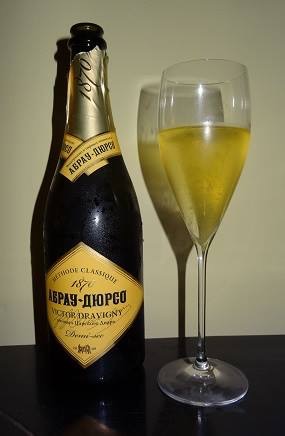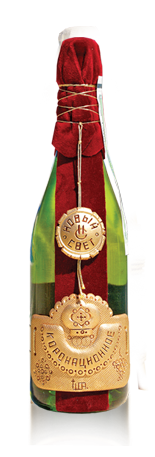 Ok, Ok, I know its not Champagne if it’s not from Epernay, France, but these vineyards have so much in common with the Champagne region they practically share the same DNA. Abrau Durso was created at the insistence of Tsar Alexander II in 1870, and thus has very strong imperial connections. The Russian Royal Family had developed a great love for Champagne, and especially Cliquot, whose famous Widow had specifically targeted the Russian market and had for years shipped bottles for consumption to the Russian court. Unlike the British, who preferred their fizz to be dry (hence the name “Brut” – a play on the French declaring this to be a ‘brutish’ way to be appreciating their precious wines) the Russians preferred sweet, or demi-sec (semi-sweet) wines. Madame Cliquot supplied the demand for many years until the Tsar decided it would be appropriate (and presumably to enjoy even more of the stuff) if Russia could make its own. He dispatched loyal courtier Prince Lev Golitsyn (who must have thought it the most excellent Russian royal command ever) to oversee the project, and in collaboration with Feodor Geiduk, an agricultural expert, decided upon a small, rugged valley about 20 kilometers north of Novorossiysk. Abrau Durso is named after two streams, the Abrau that forms a small, natural lake (the largest in the North Caucasus) and the Durso, which falls to the Black Sea two kilometers distant. The first grapes were planted in 1896 and included Riesling, Portugieser, Aligote, Sauvignon, Saperavi, and Muscat.
Ok, Ok, I know its not Champagne if it’s not from Epernay, France, but these vineyards have so much in common with the Champagne region they practically share the same DNA. Abrau Durso was created at the insistence of Tsar Alexander II in 1870, and thus has very strong imperial connections. The Russian Royal Family had developed a great love for Champagne, and especially Cliquot, whose famous Widow had specifically targeted the Russian market and had for years shipped bottles for consumption to the Russian court. Unlike the British, who preferred their fizz to be dry (hence the name “Brut” – a play on the French declaring this to be a ‘brutish’ way to be appreciating their precious wines) the Russians preferred sweet, or demi-sec (semi-sweet) wines. Madame Cliquot supplied the demand for many years until the Tsar decided it would be appropriate (and presumably to enjoy even more of the stuff) if Russia could make its own. He dispatched loyal courtier Prince Lev Golitsyn (who must have thought it the most excellent Russian royal command ever) to oversee the project, and in collaboration with Feodor Geiduk, an agricultural expert, decided upon a small, rugged valley about 20 kilometers north of Novorossiysk. Abrau Durso is named after two streams, the Abrau that forms a small, natural lake (the largest in the North Caucasus) and the Durso, which falls to the Black Sea two kilometers distant. The first grapes were planted in 1896 and included Riesling, Portugieser, Aligote, Sauvignon, Saperavi, and Muscat.
The impact was almost immediate, with the first Abrau Durso being an immediate hit at court. Prince Golitsyn though was a canny man, with vineyards nearby. Keeping the Abrau Durso estates relatively small, he had recognized that any success would mean Abrau Durso would need to buy in additional grapes from nearby estates, which upon Abrau Durso winning a Gold Medal at the 1889 Paris Exhibition under the “sparkling wine” category, was exactly what happened. Soon, Abrau Durso was buying in grapes from Golitsyn’s own Novyi Svit estate, which also got to provide the Tsar with wines and which won their own Gold Medal at the Paris Exhibition in 1900.

Prince Golitsyn’s “Coronation” Sparkling Wine, still made to the original 1896 recipe today
The Abrau Durso however has marginally the better prestige, mainly because of the Tsar’s influence. Both estates survived the 1917 revolution, albeit quality suffered. However, the Soviet still needed to impress visiting dignatories, with even Stalin getting in on the act. He was responsible for introducing the industrial quantity “Sovietskaya” sparkling wine, in part to demonstrate to foreign guests that under the Soviet system, “Even the peasants can afford to drink champagne!” That particular wine is still available today and is sweet. I make a cocktail I call “The Stalin” from it – using a brown sugar cube, a dash of Rhubarb bitters, a decent slug of Armenian brandy, then top it up with Sovietskaya into a flute. Stalin also served Sovietskaya to Churchill at Yalta, with the Big Man wisely deciding not to comment on the Champagne comparisons, although actually it’s quite a fun wine.
But I digress. Looking back at the performance of Golitsyn’s Novyi Svit and the Abrau Durso wines at the Paris exhibitions proves their pedigree – these are Russian wines beating out the best of the French in the Sparkling wine categories. A lot has happened since then of course, but with them both under careful and sympathetic management, both, and especially Abrau Durso are becoming more readily available and are excellent wines. The best ones are aged for three years, and both brands offer a Brut, a sweet sparkling red (think Lambrusco, and try it with a hard cheese like Parmesan) as well as the best, a classic Russian Demi-Sec. In my opinion this is how champagne was always meant to be, an aperitivo both crisp and effervescent yet with a touch of sweetness on the tongue. These are hard to find in France now, as the craze for Brut as the preferred varietal continues. The Russians however, even with the Brut retain a biscuity softness that the brands such as Moet appear to have mislaid. That’s a shame for the French, but good for those of us who can find Abrau Durso or Novyi Svit on the shelves. The stupidity of the EU sanctions may mean it’ll be a while before one can find these excellent wines on EU shelves again – but if you can – snap them up. Because with the top end Abrau Durso retailing for the equivalent of ten euros in St.Petersburg, you can enjoy what a good champagne should taste like, and buy plenty of it. All one needs now is to master the art of Sabrage.